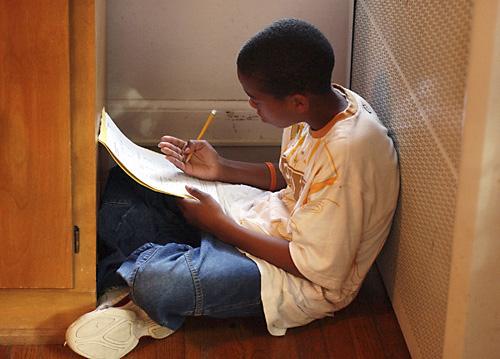Data show increase in homelessness

Damion Hackett works on his homework on Wednesday in a quiet corner of the single room he shares with his family at a Massachusetts homeless shelter. Laura Prusik
October 8, 2007
AMHERST, Mass. – There is just enough space for Lisa Rivera’s family to sleep at Jessie’s House homeless shelter.
In one room, she fits the full-sized bed she shares with her 9-year-old daughter, the trundle for her 11-year-old son, a twin bed for her 14-year-old daughter and a playpen for her 1 1/2-year old son.
“It’s comfortable, but it’s hard sleeping all together,” the 32-year-old woman said. “Oh my God, sometimes it’s so hard.”
Faced with domestic abuse, high housing costs and unemployment, Rivera’s family finds itself among the growing ranks of the homeless in Massachusetts – and possibly, the country.
About 1,800 homeless families were in Massachusetts shelters last week – up from 1,400 in June 2006 and just under 1,200 in June 2005, according to state figures. There are more families in shelters now than at any time since the inception of the state’s family shelter program in 1983, according to the Massachusetts Coalition for the Homeless.
Get The Daily Illini in your inbox!
State officials blame a wide range of problems – from cuts in assistance to the recent housing crisis.
“We’re very concerned that this is going to keep going,” said Julia Kehoe, commissioner of the state Department of Transitional Assistance.
Massachusetts is one of the few states that keep government records of the number of homeless families in shelters because state law requires the Commonwealth to shelter any family that meets income and other guidelines. The state keeps a daily count to show how many beds it needs, said Robyn Frost, executive director of the Massachusetts Coalition for the Homeless.
Nationally, the picture is much less clear.
Data from the U.S. Department of Housing and Urban Development suggests there about 750,000 homeless in the nation on any given night, with about 40 percent of those members of homeless families, said Philip Mangano, director of the U.S. Interagency Council on Homelessness.
The overall number of homeless people is up from a few years ago, he said, but nobody can pinpoint an exact number of families because reporting requirements vary widely from state to state.
“Our desire would be to have many more states step up and track the data,” Mangano said. “Research and data, that’s what should drive the resources that we make available. Instead it’s often anecdote, conjecture and hearsay that does that.”
Kehoe attributes the increase in Massachusetts to a convergence of low wages, high housing costs, an increase in housing foreclosures and cuts in federal and state housing assistance programs. Two years ago, lawmakers also lowered the financial eligibility requirements to qualify for homeless benefits from the poverty level to those making 130 percent of what would be considered a poverty wage, she said.
“I think what we are seeing here is a perfect storm,” she said. “Until we have some investment in affordable housing, and some flexibility in using our resources, we’re not going to see a leveling off of these numbers.”






